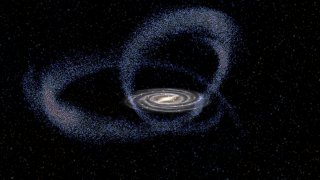The Missing Half of the Universe’s Ordinary Matter Has Been Found
So where was it after all these billions of years?
Around two decades ago, scientists predicted that about 5 percent of the universe’s matter should be of the ordinary kind, with the rest being a mixture of dark matter and dark energy. When they added everything up, however, half of the ordinary matter was missing.
Known as the “missing baryon problem,” scientists have put in countless hours to solve this conundrum—but without much success.
It appears as though the tide has turned, as mysterious fast radio bursts, or FRBs, have been used to pinpoint the “missing matter.” FRBs are powerful millisecond bursts of radio waves that can travel vast distances across the universe.
It isn’t yet known what causes this phenomenon, but the bursts can be traced back to their origin via highly sensitive telescopes. According to a study published in the journal Nature, a team of astronomers was able to use six of them to detect all of the missing “normal” matter, composed of garden-variety particles called baryons, such as protons and neutrons, in the interstellar space between stars and galaxies.
“The result has squared the cosmic ledger,” the study’s lead author Jean-Pierre Macquart, an associate professor at the Curtin University node of the International Centre for Radio Astronomy Research in Australia, said in an email to CNN.
“Decades ago, astronomers had been able to infer how much matter existed in the early universe, but up till now we were only able to account for roughly half of this in the present-day universe. Where had the matter gone?”
Macquart said the missing matter even drove astronomers to question their fundamental understanding of the early universe at times.
“It turned out that it was hiding in a density so low that it does not emit light, it doesn’t absorb it, and it doesn’t reflect it,” he said.
Macquart added that it was way back in 2007 when astronomers first realized the potential of FRBs in detecting this missing matter.
“The radiation from fast radio bursts gets spread out by the missing matter in the same way that you see the colors of sunlight being separated in a prism,” he said.
All wavelengths of FRBs travel at the same speed in empty space, but what the astronomers witnessed was that when these FRBs passed through the missing matter, they slowed down, which signaled their presence.
“Their millisecond durations made it very easy to measure the effect of dispersion—the process by which their longer wavelength emission is delayed with respect to their shorter wavelength emission is delayed—and hence to measure exactly how much matter they have encountered on their multibillion year intergalactic journeys to Earth,” Macquart said.
The research for the study was incredibly difficult because the astronomers needed to identify the particular galaxy where each FRB occurred—some of which are billions of light-years away.
Ethen Kim Lieser is a Science and Tech Editor who has held posts at Google, The Korea Herald, Lincoln Journal Star, AsianWeek and Arirang TV. He currently resides in Minneapolis.
Image: Reuters.

